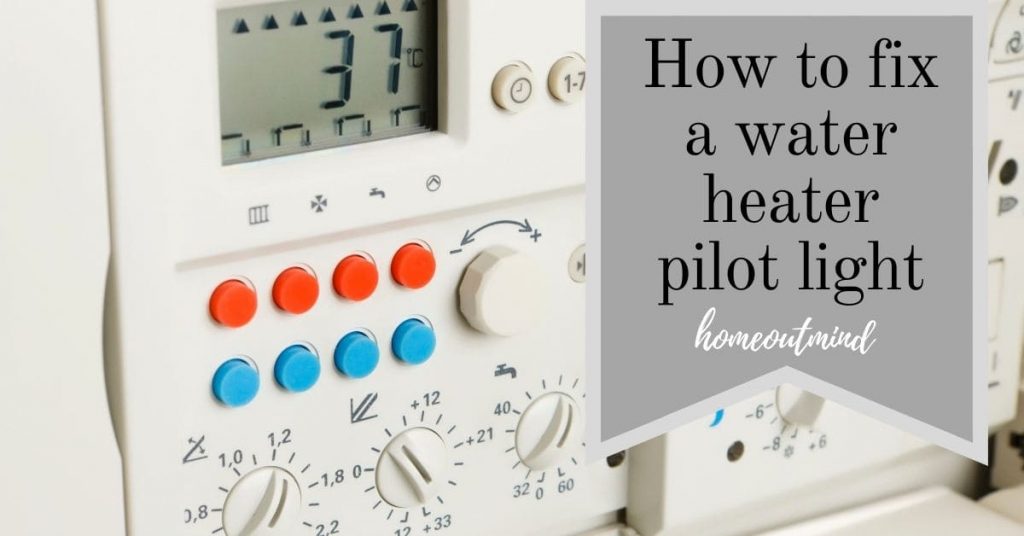Fixing a water heater pilot light issue doesn’t have to be daunting or expensive. You can troubleshoot and resolve it yourself with simple steps. Follow these instructions carefully for a hassle-free solution:

Step 1: Light the Pilot Light
1. Turn the Control Knob to “Pilot”: Press and hold the knob fully in. You’ll feel it engage about 1/4-inch.
2. Continuous Ignition: While holding the knob, click the igniter button consistently for up to 90 seconds or until the Status Light starts blinking.
3. If the Status Light Doesn’t Blink: Release the knob, wait 10 minutes, and retry. Repeat this process 2-3 times if necessary, waiting 10 minutes between attempts as per the valve’s circuitry.
4. When the Status Light Blinks: Release the control knob, set it to the desired temperature setting (approximately 120°F for “Hot”), and you’re done.
Step 2: Troubleshooting Pilot Light Issues
1. No Blinking Status Light: If the light doesn’t blink, wait 10 minutes before another attempt. If it persists, follow the lighting instructions on the water heater’s label while ensuring the control knob is set to “Pilot.”
2. Checking the Pilot: Remove the outer door and observe the pilot through the viewport (sight glass) while clicking the igniter button. Continue until the pilot lights.
Step 3: Further Troubleshooting (If Needed)
1. Pilot Doesn’t Light: Wait 10 minutes before another attempt. Ensure the igniter sparks by observing through the viewport. If the spark is visible, try relighting following the label instructions. Check for gas supply and tighten wiring connections if necessary.
3. Status Light Doesn’t Blink After Lighting: Check thermopile connections, reset the thermal switch if needed, and ensure wiring connections are tight. Wait 10 minutes and try relighting following label instructions.
Remember, safety first: Do not attempt to light the pilot if flammable vapors are present, and always ensure proper ventilation. Following these steps diligently should resolve your water heater pilot light issue efficiently and without the need for professional assistance, saving you time and money.
How to Diagnose Water Heater Flash Codes?
Understanding and diagnosing flash codes on your water heater is crucial for effective troubleshooting. Follow these steps to interpret and address various flash code indications:
Step 1: Zero Flashes (LED not lit)
Indication/Condition: Control Off/Pilot Out.
Check/Repair:
- Follow lighting instructions on the water heater and try relighting the pilot.
- If the pilot won’t hold, check for a tripped thermal switch. Reset if necessary.
- Ensure proper ventilation, clean filter, and clear flame arrestor.
- Confirm piezo igniter spark and proper gas supply.
Step 2: Status Light On (solid)
Indication/Condition: Pilot recently extinguished, thermopile cooling down.
Check/Repair:
- Turn control valve/thermostat knob to OFF.
- Wait 10 minutes, then attempt relighting following instructions.
Step 3: One Flash
Indication/Condition: Normal Operation (bright/dim heartbeat).
Check/Repair: No corrective action necessary.
Step 4: Two Flashes
Indication/Condition: Low Thermopile Voltage.
Check/Repair:
- Inspect wiring connections for damage and correct if needed.
- Check thermopile millivolt output, replace if below 350 millivolts DC.
Step 5: Four Flashes
Indication/Condition: Temperature Exceeded (ECO Activated).
Check/Repair:
- Turn control valve/thermostat knob to OFF.
- Turn main supply OFF.
- Replace control valve/thermostat.
Step 6: Five Flashes
Indication/Condition: Sensor Failure.
Check/Repair:
- Turn control valve/thermostat knob to OFF.
- Turn main supply OFF.
- Replace control valve/thermostat.
Step 7: Seven Flashes
Indication/Condition: Internal Control Failure.
Check/Repair:
- Turn control valve/thermostat knob to OFF.
- Turn main supply OFF.
- Replace control valve/thermostat.
Step 8: Eight Flashes
Indication/Condition: Power Off Failure.
Check/Repair:
- If pilot flame present in OFF position, replace control valve/thermostat.
- If pilot flame absent, wait 10 minutes, then relight. If issue persists, replace control valve/thermostat.
What Causes a Water Heater Pilot Light to Go Out?
Several factors can lead to the extinguishing of a water heater pilot light. Here’s a concise breakdown:
1. Thermocouple Malfunction: A faulty thermocouple, responsible for detecting the pilot flame, may cause the gas supply to shut off, leading to pilot light outage.
2. Gas Supply Issues: Problems with the gas supply, such as low pressure or interruptions, can prevent the pilot light from staying lit.
3. Clogged Pilot Orifice: Dirt, debris, or mineral deposits can accumulate in the pilot orifice, obstructing the flow of gas and causing the pilot light to go out.
4. Faulty Gas Valve: A defective gas valve can intermittently shut off the gas supply, resulting in pilot light failure.
5. Air Flow Problems: Inadequate combustion air or poor ventilation around the water heater can interfere with proper pilot light operation.
6. Thermostat Issues: Malfunctioning thermostat settings or wiring problems can affect the pilot light’s stability and cause it to go out unexpectedly.
What to Do If Water Heater Pilot Won’t Light
Facing a situation where the water heater pilot won’t light can be frustrating, but here’s a step-by-step to help you resolve the issue:
1. Check Gas Supply: Ensure the gas supply to the water heater is turned on. If it’s off, switch it on and wait a few minutes for the gas to flow properly.
2. Inspect Thermocouple: Verify that the thermocouple is positioned correctly and not damaged. If it appears faulty, consider replacing it with a new one.
3. Clear Pilot Orifice: Use compressed air or a small wire to clear any debris or buildup from the pilot orifice, allowing gas to flow freely.
4. Relight Pilot: Follow the manufacturer’s instructions for relighting the pilot. Turn the control knob to the pilot position, press and hold it in, and use the igniter button to light the pilot flame. Continue holding the knob for a few moments after the pilot is lit to ensure it stays lit.
5. Check for Flame Stability: Once the pilot is lit, observe its flame. It should be steady and blue. If it flickers or appears weak, there may be an issue with gas flow or combustion.
6. Verify Safety Features: Some water heaters have safety features like a thermal switch that may need to be reset if tripped. Check the owner’s manual for instructions on how to reset any safety devices.
7. Professional Assistance: If you’ve tried the above steps and the pilot still won’t light, or if you’re uncomfortable with troubleshooting gas appliances, it’s best to contact a qualified technician or plumber for further diagnosis and repair.
How to Relight the Pilot Light on Your Water Heater?
Relighting the pilot light on your water heater is a straightforward process. Here’s a step-by-step guide:
1. Locate the Control Knob: Find the control knob on your water heater. It’s typically located near the bottom of the unit, often behind a small access panel.
2. Turn the Knob to “Pilot”: Rotate the control knob to the “Pilot” position. You may need to push it in slightly to engage this setting.
3. Press and Hold the Knob: Maintain pressure on the control knob, keeping it in the “Pilot” position. This action facilitates the flow of gas to the pilot light.
4. Ignite the Pilot: While holding the control knob, use a long-reach lighter or built-in igniter (if available) to ignite the pilot light. Hold the flame near the pilot burner while continuing to press the knob.
5. Keep Holding for a Few Seconds: After the pilot light ignites, continue holding the control knob in the “Pilot” position for about 30 seconds to 1 minute. This allows the thermocouple to heat up and signal the gas valve to keep the pilot light on.
6. Release the Control Knob: Once the pilot flame stays lit on its own, release the control knob slowly. The pilot light should remain lit.
7. Turn the Knob to “On”: If your water heater has a separate setting for “On” or “Normal,” turn the control knob to this position. This will allow the main burner to ignite and heat the water.
8. Close Access Panel: If you removed an access panel to access the control knob, securely close it back in place.
9. Verify Operation: Check to ensure that the main burner ignites and that hot water is being produced normally.
Frequently Asked Questions:
How do you turn on an electric water heater?
To initiate your electric water heater, locate the circuit breaker or fuse box in your home. Ensure the breaker or fuse corresponding to the water heater is in the “on” position. This step provides power to the water heater’s heating elements.
For a detailed walkthrough including safety precautions and troubleshooting tips, delve into our comprehensive guide on Turning On an Electric Water Heater.
How to clean a tankless water heater?
Regular maintenance, including cleaning, is vital to uphold the efficiency and longevity of your tankless water heater. The process involves flushing out mineral deposits and debris that accumulate over time, hindering performance.
Dive deep into our extensive guide on Cleaning a Tankless Water Heater to discover effective descaling methods, maintenance schedules, and expert recommendations to keep your unit running smoothly.
How to fix an RV water heater?
A malfunctioning RV water heater can put a damper on your travel plans. Fortunately, many issues can be diagnosed and resolved with basic troubleshooting techniques.
From addressing pilot light problems to tackling gas supply issues, our detailed post on Fixing an RV Water Heater offers step-by-step instructions, safety precautions, and common pitfalls to avoid.
How to install a hot water heater element?
When it’s time to replace the heating element in your hot water heater, proper installation is crucial for optimal performance and safety.
Our in-depth guide on Installing a Hot Water Heater Element walks you through each stage of the process, from draining the tank to wiring the new element.
Gain insights into selecting the right replacement element, troubleshooting potential challenges, and ensuring a seamless installation experience.
How to replace a thermocouple on a water heater?
A malfunctioning thermocouple can disrupt the operation of your water heater’s pilot light, leading to inconsistent heating and potential safety hazards.
Learn how to safely replace the thermocouple in our comprehensive post on Replacing a Thermocouple on a Water Heater. We cover everything from identifying signs of a faulty thermocouple to selecting the correct replacement part and conducting the replacement procedure with confidence.
Read also:
- How to test a water heater element?
- How to turn up hot water heater electric?
- How to vent a tankless water heater?
- Why is the water heater leaking?
By following these diagnostic steps, you can effectively address various issues with your water heater pilot light, ensuring efficient and safe operation.
Final Thoughts
In conclusion, mastering the steps to fix a water heater pilot light empowers you to troubleshoot and resolve common issues efficiently. Prioritize safety, follow the instructions carefully, and restore your water heater’s functionality with confidence.
If needed, seek professional assistance for complex problems. With these skills, you can ensure uninterrupted access to hot water in your home.






